1.1 The History and Scope of Psychology
2

According to portrayals in the news and popular media, psychologists seem to analyze personality, offer counseling, dispense child-
Have you ever found yourself reacting to something as one of your biological parents would—
perhaps in a way you vowed you never would— and then wondered how much of your personality you inherited? To what extent do genes predispose our individual personality differences? To what extent do home and community environments shape us? Have you ever worried about how to act among people of a different culture, race, gender, or sexual orientation? In what ways are we alike as members of the human family? How do we differ?
Have you ever awakened from a nightmare and, with a wave of relief, wondered why you had such a crazy dream? How often, and why, do we dream?
Have you ever played peekaboo with a 6-
month- old and wondered why the baby finds the game so delightful? What do babies actually perceive and think? Have you ever wondered what fosters school and work success? Are some people just born smarter? Does sheer intelligence explain why some people get richer, think more creatively, or relate more sensitively?
Have you ever become depressed or anxious and wondered whether you’ll ever feel “normal”? What triggers our bad moods—
and our good ones? What’s the line between a normal mood swing and a psychological disorder?
Psychology is a science that seeks to answer such questions.
1-
To assist your active learning of psychology, numbered Learning Objectives, framed as questions, appear at the beginning of major sections. You can test your understanding by trying to answer the question before, and then again after, you read the section.
Underlying all science is, first, a hard-
Magician and paranormal investigator James Randi has used this empirical approach when testing those claiming to see glowing auras around people’s bodies:
Randi: Do you see an aura around my head?
Aura seer: Yes, indeed.
Randi: Can you still see the aura if I put this magazine in front of my face?
Aura seer: Of course.
Randi: Then if I were to step behind a wall barely taller than I am, you could determine my location from the aura visible above my head, right?
Randi once told me [DM] that no aura seer had yet agreed to take this simple test.

No matter how sensible-
3
“To believe with certainty,” says a Polish proverb, “we must begin by doubting.” As scientists, psychologists approach the world of behavior with a curious skepticism, persistently asking two questions: What do you mean? How do you know?
Putting a scientific attitude into practice requires not only curiosity and skepticism but also humility—
Historians of science tell us that these three attitudes—
Of course, scientists, like anyone else, can have big egos and may cling to their preconceptions. It’s easy to get defensive when others challenge our cherished ideas. Nevertheless, the ideal of curious, skeptical, humble scrutiny of competing ideas unifies psychologists as a community as they check and recheck one another’s findings and conclusions.
“My deeply held belief is that if a god anything like the traditional sort exists, our curiosity and intelligence are provided by such a god. We would be unappreciative of those gifts … if we suppressed our passion to explore the universe and ourselves.”
Carl Sagan, Broca’s Brain, 1979

Critical Thinking
Throughout the text, important concepts are boldfaced. As you study, you can roll over these terms and their definitions will pop up. They can also be found in the Glossary at the end of the book.
critical thinking thinking that does not blindly accept arguments and conclusions. Rather, it examines assumptions, appraises the source, discerns hidden biases, evaluates evidence, and assesses conclusions.
The scientific attitude prepares us to think smarter. Critical thinking examines assumptions, appraises the source, discerns hidden biases, evaluates evidence, and assesses conclusions. Whether reading online commentary or listening to a conversation, critical thinkers ask questions: How do they know that? What is this person’s agenda? Is the conclusion based on a personal story and gut feelings, or on evidence? Does the evidence justify a cause-
From a Twitter feed:
“The problem with quotes on the Internet is that you never know if they’re true.”
Abraham Lincoln
Critical inquiry can lead us to surprising findings. Some examples from psychological science: Massive losses of brain tissue early in life may have minimal long-
4
Critical inquiry sometimes also debunks popular presumptions, as we will see in ensuing chapters. Evidence indicates that sleepwalkers are not acting out their dreams (see Chapter 3). Our past experiences are not all recorded verbatim in our brains; with brain stimulation or hypnosis, one cannot simply “hit the replay button” and relive long-

Psychology’s critical inquiry can also identify effective policies. To deter crime, should we invest money in lengthening prison sentences or increase the likelihood of arrest? To help people recover from a trauma, should counselors help them relive it, or not? To increase voting, should we tell people about the low turnout problem, or emphasize that their peers are voting? When put to critical thinking’s test—
Throughout the book, information sources are cited in parentheses, with researchers’ names and the date the research was published. Every citation can be found in the end-
Study Tip: Memory research reveals a testing effect: We retain information much better if we actively retrieve it by self-
RETRIEVE IT
Question
J/sn3SxTaBxU808GiTvEgPQQj2Yw5PH+haGlMtzXG6JpC+kMIrNEtrFzffy9GMJJgm45GjlZDmp7Bz4dgryvzxsUX3rOrZE34bFBIHJOcuWkVmP0hUNCVz+iQDD2Iu9X3UokQMd7/FJxf9XrNAMh8ZWcszbtG/afdK1fov6jvh5WHGz99j/yh7yU48Jz/KKBE9e9v7ClK+G7XwmXNkq8Sh7rUVhDeT+gkMGvlM1zEPkC1BQ7pGaLoyEohniXbl74jtwNtJde7oxRpnFRIsgoU0dSevI1zY2yPsychology’s Roots
1-
To be human is to be curious about ourselves and the world around us. Before 300 B.C.E., the Greek philosopher Aristotle theorized about learning and memory, motivation and emotion, perception and personality. Today we chuckle at some of his guesses, like his suggestion that the source of our personality is the heart. But credit Aristotle with asking the right questions.
Psychological Science Is Born
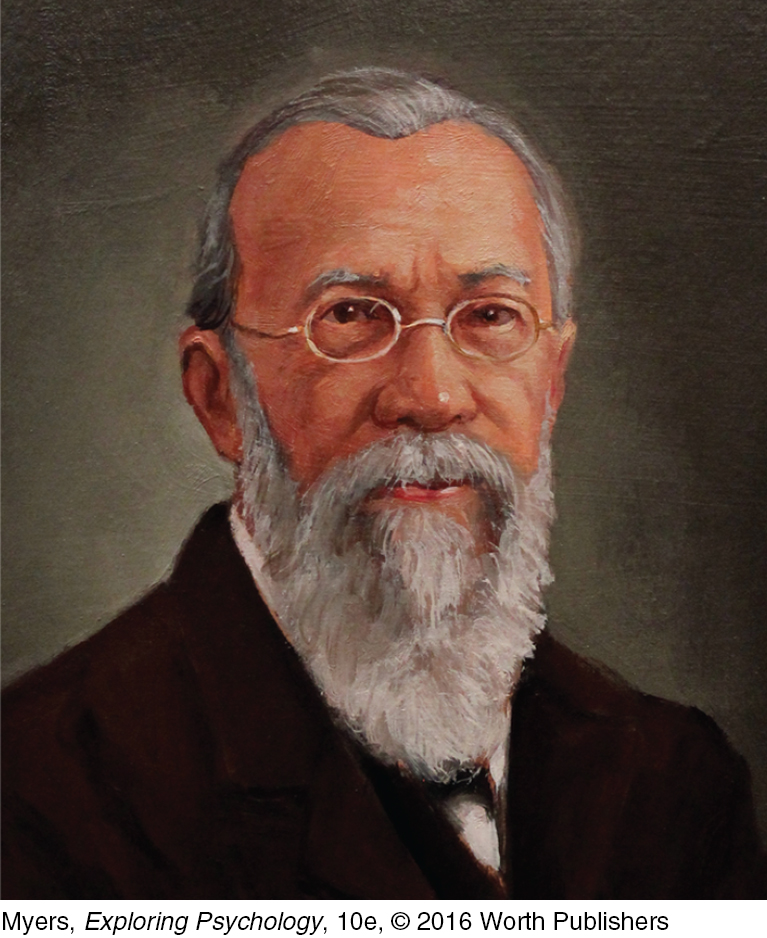
PSYCHOLOGY’S FIRST LABORATORY Philosophers’ thinking about thinking continued until the birth of psychology on a December day in 1879, in a small, third-
structuralism early school of thought promoted by Wundt and Titchener; used introspection to reveal the structure of the human mind.
functionalism early school of thought promoted by James and influenced by Darwin; explored how mental and behavioral processes function—
5
PSYCHOLOGY’S FIRST SCHOOLS OF THOUGHT Before long, this new science of psychology became organized into different branches, or schools of thought, each promoted by pioneering thinkers. Two early schools were structuralism and functionalism. As physicists and chemists discerned the structure of matter, so psychologist Edward Bradford Titchener aimed to discover the mind’s structure. He engaged people in self-
Philosopher-
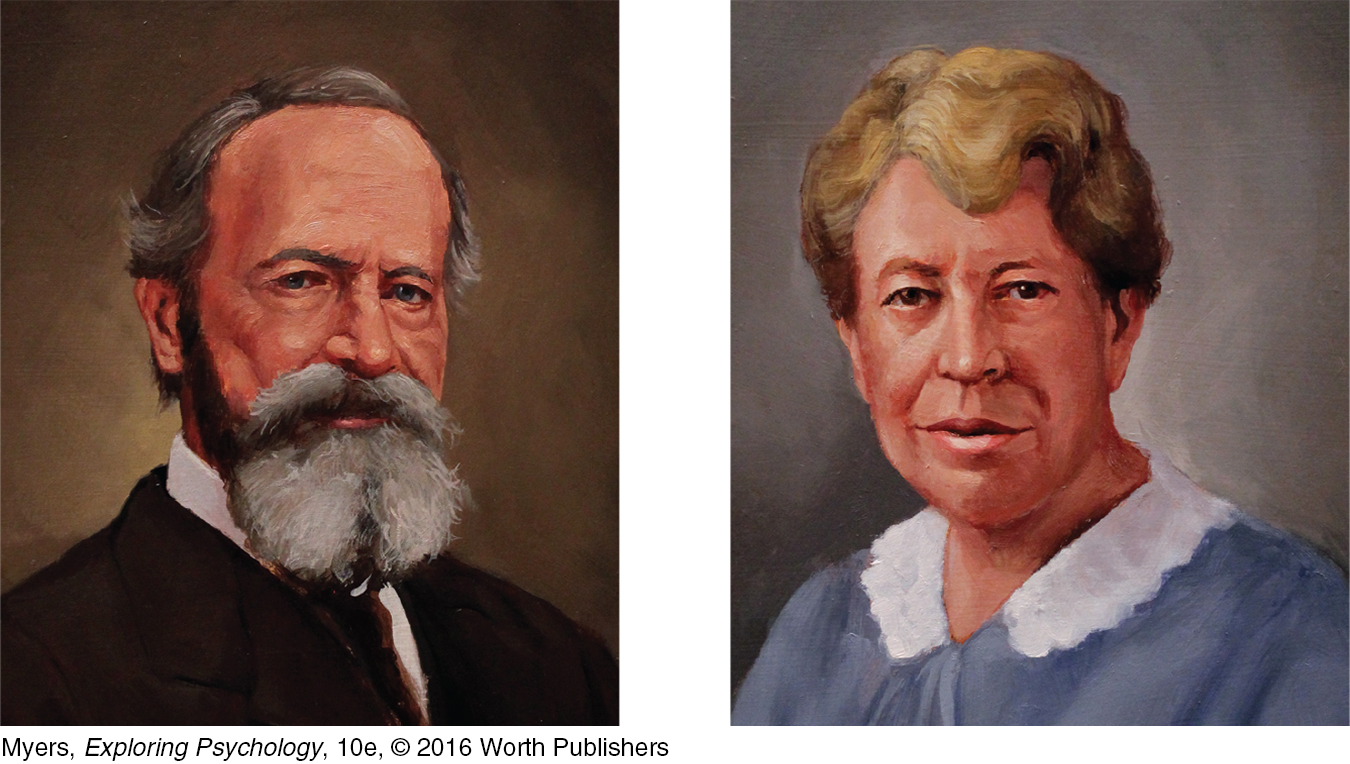
PSYCHOLOGY’S FIRST WOMEN As these names illustrate, the early pioneers of most fields, including psychology, were predominantly men. In 1890—
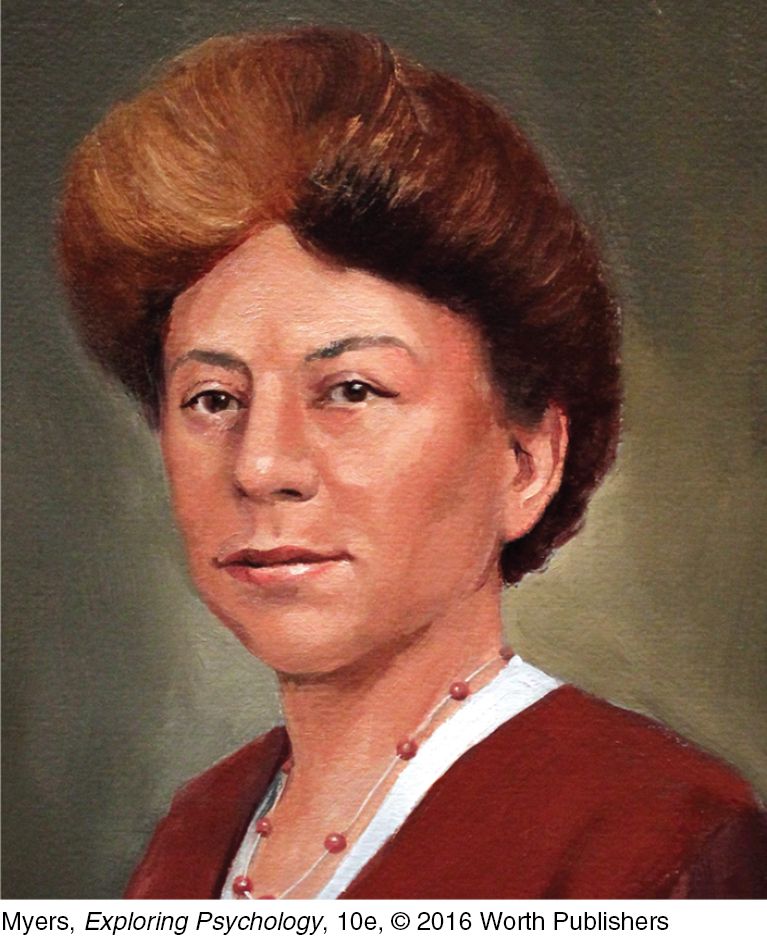
6
The honor of being the first official female psychology Ph.D. later fell to Margaret Floy Washburn, who also wrote an influential book, The Animal Mind, and became the APA’s second female president in 1921. But Washburn’s gender barred doors for her, too. Although her thesis was the first foreign study Wundt published in his psychology journal, she could not join the all-
RETRIEVE IT
Question
krlHKrdiYDs7A2yZWpmBEdkZ9XI3LU475RVUQ0PlH/hyBIV+iCxn5IGdq3lZY1bT/H+a8uQYLWl/UTfIUadWIPAOYcFD9ijIKPboSyILuUbjwkTNVqPBbrYDY0go4L6MsAjPPg==Question
zxgK6dNeb3zsX+J0+cbF7tjEDX6+L0Xj8ywOUBu49nmT7/V1rwlik67gL2If4+PQa2bNzSwf+FcedlsU7Vc/056TMxN66hLGyePQgdtCq9cS1MA8UiJY28a5o7fS5NsZc6AYJBsgrOznpeN0c6I4miNoJE5nXsDZGJBhkQ==Question
The school of M5PQOH+JfRZlFcQVeqSeobzq+zE= used introspection to define the mind's makeup; KSNdR2xfuYgIStMBsBZ/jZvHSBs= focused on how mental processes enable us to adapt, survive, and flourish.
Psychological Science Develops
1-
In psychology’s early days, many psychologists shared with English essayist C. S. Lewis the view that “there is one thing, and only one in the whole universe which we know more about than we could learn from external observation.” That one thing, Lewis said, is ourselves: “We have, so to speak, inside information” (1960, pp. 18-
That definition endured until the 1920s, when the first of two provocative American psychologists appeared on the scene.
behaviorism the view that psychology (1) should be an objective science that (2) studies behavior without reference to mental processes. Most psychologists today agree with (1) but not with (2).

BEHAVIORISM John B. Watson, and later B. F. Skinner, dismissed introspection and redefined psychology as “the scientific study of observable behavior.” You cannot observe a sensation, a feeling, or a thought, they said. But you can observe and record people’s behavior as they are conditioned—
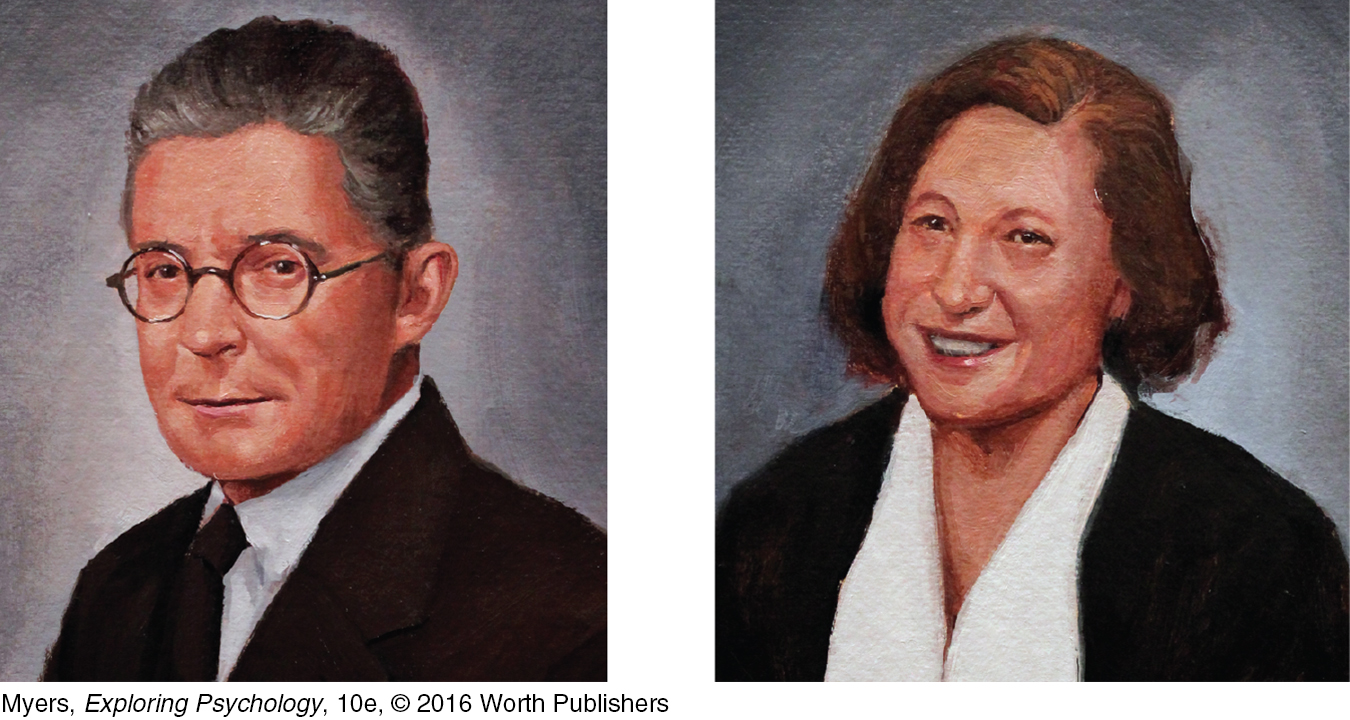

FREUDIAN PSYCHOLOGY The second major force was Freudian psychology, which emphasized the ways our unconscious thought processes and emotional responses to childhood experiences affect our behavior. (In chapters to come, we’ll look more closely at Sigmund Freud’s ideas.)
humanistic psychology historically significant perspective that emphasized human growth potential.
7
HUMANISTIC PSYCHOLOGY As the behaviorists had rejected the early-
psychology the science of behavior and mental processes.
MODERN DEFINITION OF PSYCHOLOGY Today’s psychology builds upon the work of these earlier scientists and their schools of thought. To encompass psychology’s concern with observable behavior and with inner thoughts and feelings, today we define psychology as the science of behavior and mental processes. Let’s unpack this definition. Behavior is anything an organism does—
The key word in psychology’s definition is science. Psychology is less a set of findings than a way of asking and answering questions. Our aim, then, is not merely to report results but also to show you how psychologists play their game. You will see how researchers evaluate conflicting opinions and ideas. And you will learn how all of us, whether scientists or simply curious people, can think smarter when experiencing and explaining the events of our lives.
RETRIEVE IT
Question
From the 1920s through the 1960s, the two major forces in psychology were DJ21ECxbmckHTH6DA1f6iYieygAHysDq and ichklafLjtDE9qN4S/U5ZAAkCeKi75OD psychology.
Contemporary Psychology
1-
Psychology’s roots lie in many disciplines and countries. The young science of psychology developed from the more established fields of philosophy and biology. Wundt was both a philosopher and a physiologist. Ivan Pavlov, who pioneered the study of learning, was a Russian physiologist. Freud was an Austrian physician. Jean Piaget, the last century’s most influential observer of children, was a Swiss biologist. James was an American philosopher. This list of pioneering psychologists—
Like the pioneers, today’s psychologists are citizens of many lands. The International Union of Psychological Science has 82 member nations, from Albania to Zimbabwe. Psychology is growing and it is globalizing. The story of psychology is being written in many places, with interests ranging from nerve cell activity to international conflicts.
The Cognitive Revolution
cognitive neuroscience the interdisciplinary study of the brain activity linked with cognition (including perception, thinking, memory, and language).
Psychologists in the 1960s pioneered a “cognitive revolution,” leading the field back to its early interest in mental processes. Cognitive psychology today continues its scientific exploration of how we perceive, process, and remember information, and the cognitive roots of anxiety, depression, and other psychological disorders. Cognitive neuroscience was birthed by the marriage of cognitive psychology (the science of mind) and neuroscience (the science of brain). This interdisciplinary field studies the brain activity underlying mental activity.
Evolutionary Psychology and Behavior Genetics
8
nature–nurture issue the longstanding controversy over the relative contributions that genes and experience make to the development of psychological traits and behaviors. Today’s science sees traits and behaviors arising from the interaction of nature and nurture.

Are our human traits present at birth, or do they develop through experience? The debate over this huge nature–nurture issue is ancient. Greek philosopher Plato (428–
natural selection the principle that those chance inherited traits that better enable an organism to survive and reproduce in a particular environment will most likely be passed on to succeeding generations.
More insight into nature’s influence on behavior arose after a 22-
evolutionary psychology the study of the evolution of behavior and the mind, using principles of natural selection.
behavior genetics the study of the relative power and limits of genetic and environmental influences on behavior.
The nature–
Over and over again we will see that in contemporary science, the nature–
RETRIEVE IT
Question
2bJoZ0nSgxgY8Bw2WKYh/pF8zmNfV5+lZqkG5EWn4fKAyu4Rs0K1jnc0uHgq4ayeV6p4yWG8Kqf6sDIJSsvLemvE++aiPdK/fPH/Vr7Sfr1JPHhz+psDytd7g42HqxqlyLX3gDj0E7ukrZqNvVzSzA==Question
Rh4yahALcS7TCuYrDq1d7hzL3oS/32qosRg6n13pfI3DPUONv8Z5nTkgkOigMrD3BxAFFAXvW5SaavYIF7ITGvJUwPQNydWXQuestion
h0F/tE38NbIUKqqF2dViPtnYZ4OttY+ayZOtSaOaY3U84mAfvbsDkepZn/RzmzDclUs+/PJZQ1sgR9TZjZXwzu7FcYgRvp2wWbh7+JPOmNuYmizRrMAkSVV8gqfiEuBgPXLCrOgh8R3dWKhMbflSvuzl6pjN/A+5U2qUl7Be3vePHa5h7o1l/MBmLVrjBbb+IDcw0M/kvhwI7iaQauBGnGiiGPLTIfOrCross-Cultural and Gender Psychology
9
“All people are the same; only their habits differ.”
Confucius, 551–
culture the enduring behaviors, ideas, attitudes, values, and traditions shared by a group of people and transmitted from one generation to the next.

What can we learn about people in general from psychological studies done in one time and place—
It is also true, however, that our shared biological heritage unites us as a universal human family. The same underlying processes guide people everywhere. Some examples:
People with specific learning disorder (formerly called dyslexia) exhibit the same brain malfunction whether they are Italian, French, or British (Paulesu et al., 2001).
Variation in languages may impede communication across cultures. Yet all languages share deep principles of grammar, and people from opposite hemispheres can communicate with a smile or a frown.
People in different cultures vary in feelings of loneliness (Lykes & Kemmelmeier, 2014). But across cultures, loneliness is magnified by shyness, low self-
esteem, and being unmarried (Jones et al., 1985; Rokach et al., 2002).
We are each in certain respects like all others, like some others, and like no other. Studying people of all races and cultures helps us discern our similarities and our differences, our human kinship and our diversity.
You will see throughout this book that gender matters, too. Researchers report gender differences in what we dream, in how we express and detect emotions, and in our risk for alcohol use disorder, depression, and eating disorders. Gender differences fascinate us, and studying them is potentially beneficial. For example, many researchers have observed that women carry on conversations more readily to build relationships, while men talk more to give information and advice (Tannen, 2001). Knowing this difference can help us prevent conflicts and misunderstandings in everyday interactions.
But again, psychologically as well as biologically, women and men are overwhelmingly similar. Whether female or male, we learn to walk at about the same age. We experience the same sensations of light and sound. We remember vivid emotional events and forget mundane details. We feel the same pangs of hunger, desire, and fear. We exhibit similar overall intelligence and well-
The point to remember: Even when specific attitudes and behaviors vary by gender or across cultures, as they often do, the underlying processes are much the same.
Positive Psychology
10
 is a research-
is a research-
positive psychology the scientific study of human functioning, with the goals of discovering and promoting strengths and virtues that help individuals and communities to thrive.
Psychology’s first hundred years focused on understanding and treating troubles, such as abuse and anxiety, depression and disease, prejudice and poverty. Much of today’s psychology continues the exploration of such challenges. Without slighting the need to repair damage and cure disease, Martin Seligman and others (2002, 2005, 2011) have called for more research on human flourishing. These psychologists call their approach positive psychology. They believe that happiness is a by-
Psychology’s Three Main Levels of Analysis
1-
Each of us is a complex system that is part of a larger social system. But each of us is also composed of smaller systems, such as our nervous system and body organs, which are composed of still smaller systems—
levels of analysis the differing complementary views, from biological to psychological to social-
biopsychosocial approach an integrated approach that incorporates biological, psychological, and social-
These tiered systems suggest different levels of analysis, which offer complementary outlooks. It’s like explaining horrific school shootings. Is it because the shooters have brain disorders or genetic tendencies that cause them to be violent? Because they have been rewarded for violent behavior? Because they live in a gun-
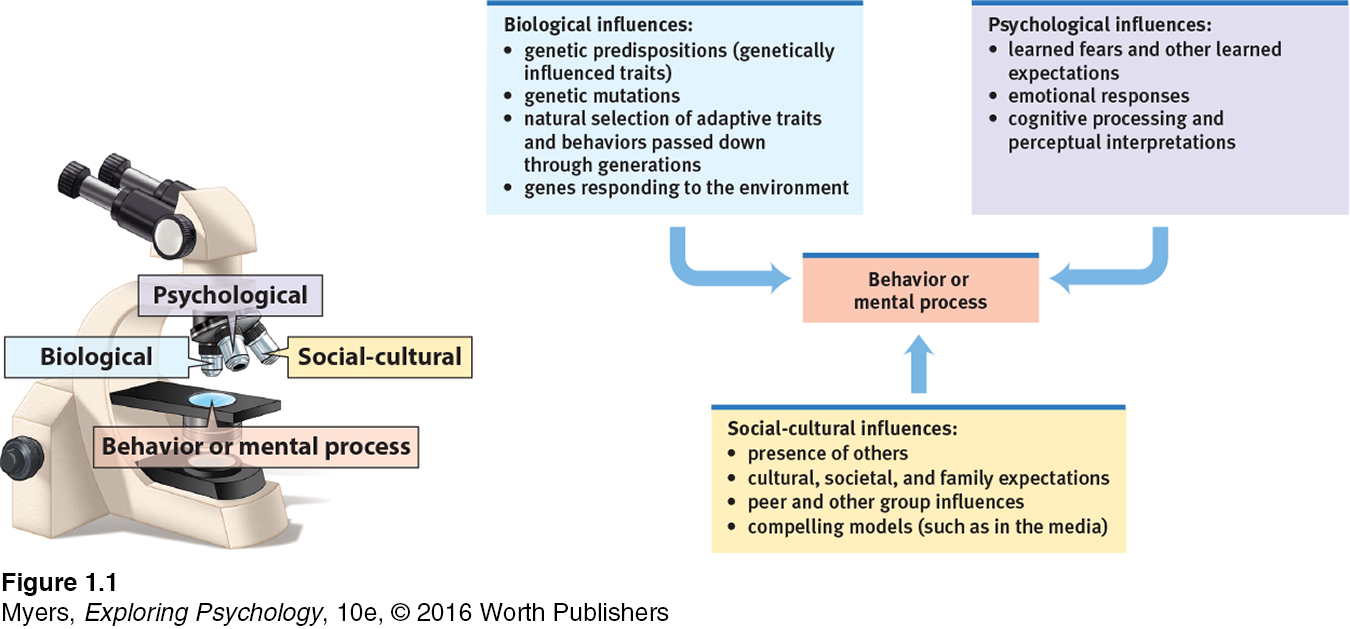
 Video: The History of Psychology.
Video: The History of Psychology.
Each level provides a valuable playing card in psychology’s explanatory deck. It’s a vantage point for viewing a behavior or mental process, yet each by itself is incomplete. Like different academic disciplines, psychology’s varied perspectives ask different questions and have their own limits. The different perspectives described in TABLE 1.1 complement one another. Consider, for example, how they shed light on anger:
11
Someone working from a neuroscience perspective might study brain circuits that cause us to be red in the face and “hot under the collar.”
Someone working from an evolutionary perspective might analyze how anger facilitated the survival of our ancestors’ genes.
Someone working from a behavior genetics perspective might study how heredity and experience influence our individual differences in temperament.
Someone working from a psychodynamic perspective might view an outburst as an outlet for unconscious hostility.
Someone working from a behavioral perspective might attempt to determine what triggers angry responses or aggressive acts.
Someone working from a cognitive perspective might study how our interpretation of a situation affects our anger and how our anger affects our thinking.
Someone working from a social-
cultural perspective might explore how expressions of anger vary across cultural contexts.
Psychology’s Current Perspectives
| Perspective | Focus | Sample Questions | Examples of Subfields Using This Perspective |
|---|---|---|---|
| Neuroscience | How the body and brain enable emotions, memories, and sensory experiences | How do pain messages travel from the hand to the brain? How is blood chemistry linked with moods and motives? | Biological; cognitive; clinical |
| Evolutionary | How the natural selection of traits has promoted the survival of genes | How does evolution influence behavior tendencies? | Biological; developmental; social |
| Behavior genetics | How our genes and our environment influence our individual differences | To what extent are psychological traits such as intelligence, personality, sexual orientation, and vulnerability to depression products of our genes? Of our environment? | Personality; developmental; legal/forensic |
| Psychodynamic | How behavior springs from unconscious drives and conflicts | How can someone’s personality traits and disorders be explained by unfulfilled wishes and childhood traumas? | Clinical; counseling; personality |
| Behavioral | How we learn observable responses | How do we learn to fear particular objects or situations? What is the most effective way to alter our behavior, say, to lose weight or stop smoking? | Clinical; counseling; industrial- |
| Cognitive | How we encode, process, store, and retrieve information | How do we use information in remembering? Reasoning? Solving problems? | Cognitive neuroscience; clinical; counseling; industrial- |
| Social- |
How behavior and thinking vary across situations and cultures | How are we alike as members of one human family? How do we differ as products of our environment? | Developmental; social; clinical; counseling |

The point to remember: Like two-
RETRIEVE IT
Question
8ojhElZ7yAa9qlAZdoeXK3R13rCNMXSAMM2G5VPbz1/Ig6TCv2gpuZF7Z6YrDC/c5Ho/lmL4WKxaLBjUor1gkRQWuSfBVeS8UOzlMnv4yyp221gbBHSuMbVLdQzB5ngTQkG7UD+wFMRh24ldMCXoJlI/UKes2TwlCQtUQqoBSm/ONubgMuTpa+pctOLuWPuDQuestion
The oKGx/GJi2BDxrZ2aU9hjeBWl6yM= perspective in psychology focuses on how behavior and thought differ from situation to situation and from culture to culture, while the LnWOSE1nzddzPyTb1+6tjA== perspective emphasizes observation of how we respond to and learn in different situations.
Psychology’s Subfields
12
1-

Picturing a chemist at work, you probably envision a scientist in a laboratory, surrounded by test tubes and high-
a white-
coated scientist probing a rat’s brain. an intelligence researcher measuring how quickly an infant shows boredom by looking away from a familiar picture.
an executive evaluating a new “healthy lifestyles” training program for employees.
a researcher at a computer analyzing “big data” from Twitter or Facebook status updates.
a therapist listening carefully to a depressed client’s thoughts.
a traveler visiting another culture and collecting data on variations in human values and behaviors.
a teacher or writer sharing the joy of psychology with others.
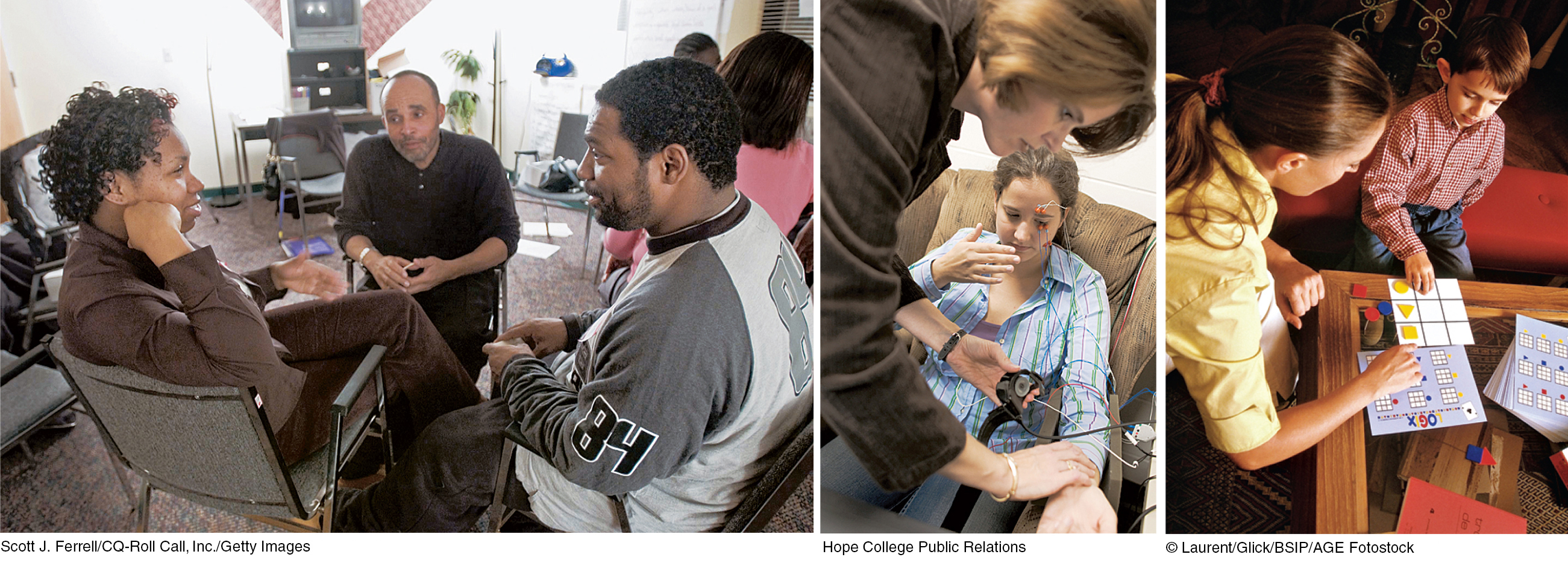
The cluster of subfields we call psychology is a meeting ground for different disciplines. Thus, it’s a perfect home for those with wide-
basic research pure science that aims to increase the scientific knowledge base.
Some psychologists conduct basic research that builds psychology’s knowledge base. We will meet a wide variety of such researchers, including biological psychologists exploring the links between brain and mind; developmental psychologists studying our changing abilities from womb to tomb; cognitive psychologists experimenting with how we perceive, think, and solve problems; personality psychologists investigating our persistent traits; and social psychologists exploring how we view and affect one another.
applied research scientific study that aims to solve practical problems.
These and other psychologists also may conduct applied research, tackling practical problems. Industrial-
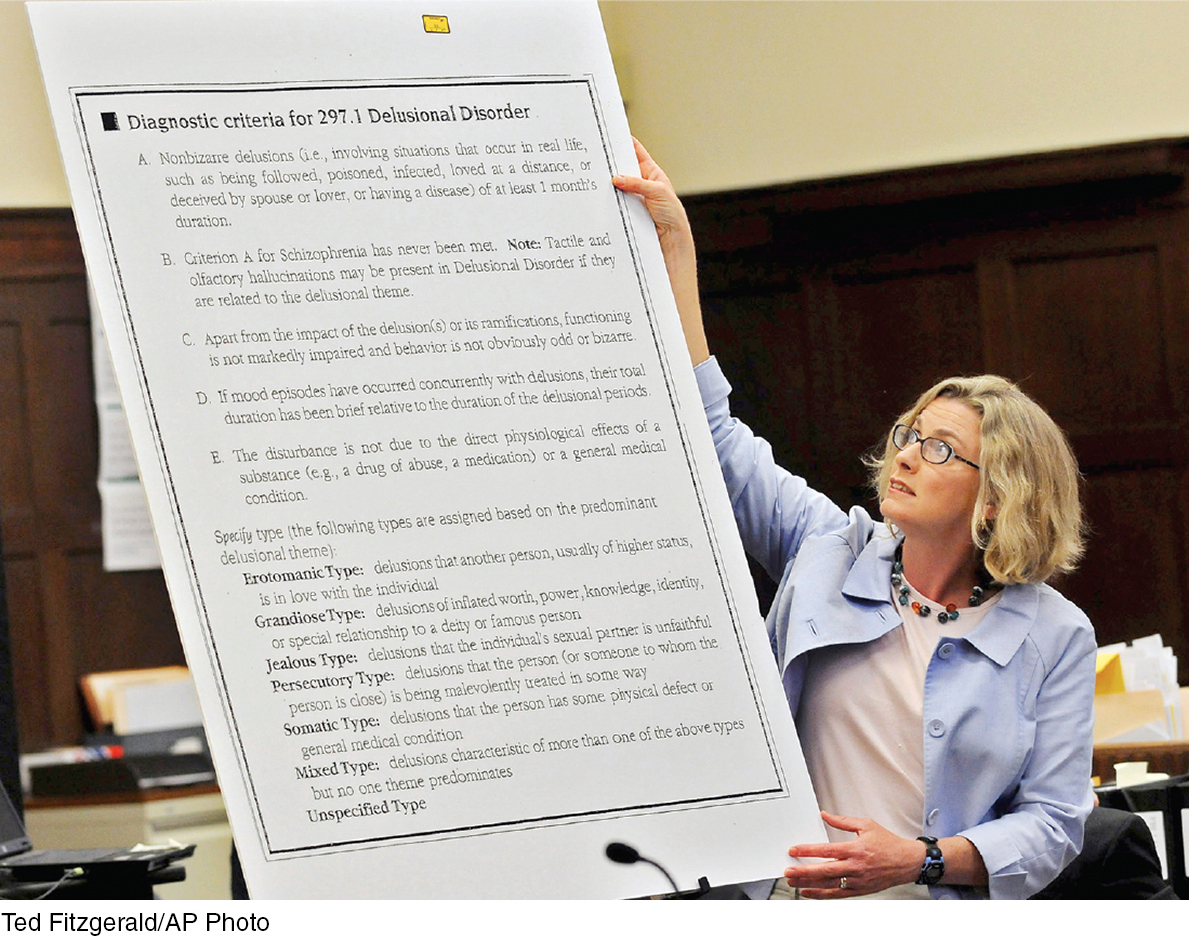
counseling psychology a branch of psychology that assists people with problems in living (often related to school, work, or marriage) and in achieving greater well-
clinical psychology a branch of psychology that studies, assesses, and treats people with psychological disorders.
psychiatry a branch of medicine dealing with psychological disorders; practiced by physicians who sometimes provide medical (for example, drug) treatments as well as psychological therapy.
Although most psychology textbooks focus on psychological science, psychology is also a helping profession devoted to such practical issues as how to have a happy marriage, how to overcome anxiety or depression, and how to raise thriving children. As a science, psychology at its best bases such interventions on evidence of effectiveness. Counseling psychologists help people to cope with challenges and crises (including academic, vocational, and marital issues) and to improve their personal and social functioning. Clinical psychologists assess and treat people with mental, emotional, and behavior disorders. Both counseling and clinical psychologists administer and interpret tests, provide counseling and therapy, and sometimes conduct basic and applied research. By contrast, psychiatrists, who also may provide psychotherapy, are medical doctors licensed to prescribe drugs and otherwise treat physical causes of psychological disorders.
community psychology a branch of psychology that studies how people interact with their social environments and how social institutions affect individuals and groups.
Rather than seeking to change people to fit their environment, community psychologists work to create social and physical environments that are healthy for all (Bradshaw et al., 2009; Trickett, 2009). To prevent bullying, for example, they might study how the school and neighborhood foster bullying and how to increase bystander intervention (Polanin et al., 2012).
 Want to learn more? See Appendix C, Subfields of Psychology, at the end of this book, and go to LaunchPad’s regularly updated Careers in Psychology resource to learn about the many interesting options available to those with bachelor’s, master’s, and doctoral degrees in psychology.
Want to learn more? See Appendix C, Subfields of Psychology, at the end of this book, and go to LaunchPad’s regularly updated Careers in Psychology resource to learn about the many interesting options available to those with bachelor’s, master’s, and doctoral degrees in psychology.
13
With perspectives ranging from the biological to the social, and with settings ranging from the laboratory to the clinic to the office, psychology relates to many fields. Psychologists teach not only in psychology departments, but also in medical schools, business schools, law schools, and theological seminaries, and they work in hospitals, factories, and corporate offices. They engage in interdisciplinary studies, such as psychohistory (the study of people’s historical motivations), psycholinguistics (the study of language and thinking), and psychoceramics (the study of crackpots).1
Psychology also influences culture. And psychology deepens our appreciation for how we humans perceive, think, feel, and act. By so doing it can indeed enrich our lives and enlarge our vision. Through this book we hope to help guide you toward that end. As educator Charles Eliot said a century ago: “Books are the quietest and most constant of friends, and the most patient of teachers.”
RETRIEVE IT
Match the specialty on the left with the description on the right.
Question
iuzVyZS1BDb3L2QED56C01IFH447S99Hfp0scix0Wdp3lwXymEtOLx8ISsdOK1ghl2m/NNMLjzKxhz/5d+crQKXMUQukhdAFKiiqIsi//0VlFqMK9N2Bl5x1iyzs7wEADBtvg5kAAaIH0zIZs8tbDjSe8VcQdvDGYW5N4xLOSZsvoBSwhUV/TWsJ9Vcg08cWNmF23qS4tBV2rvztAaNXw4S3we6SUIbLkwq1UEq7Oxj6MgvqriBxyi6Qo6HEWMVtkPmWcO3jxe1eTJMmfvoGFV59jV/yAFG5TGAJspoMIVIGBP+7Z3B77KJJG3AmbMQpGJ02PIR5bjQ+PyW4ijLjj7+PmQzF+Q2i0dtNSwOjrl0MApAFvw/wA7wG5nEIqBd/eevkkI3aGb0g/SlUla0caGq4vspXCjL7jWozqsDjq8X2J5ZLL3ufM4Q6q+Y=Learning Objectives
Test Yourself by taking a moment to answer each of these Learning Objective Questions (repeated here from within the chapter). Research suggests that trying to answer these questions on your own will improve your long-
Question
/6lGH4M/Cf3aysmjJRrszwV9eJ3ZNwtks7E2IXri0jmlibOY+aILIEMM5u9c/oANx3Cg2vMjdUMDoTec/5aFP/eEf+F9FaApW/vrB0AqklIr1mHCsOjkx4AgrlEigBdpMPLRCCv1SyCEuu67ewXtmZqUN0fNQ3rymlarcz/1DuCLvZzURQLhqV/6X1PwXvQxd8fz8S1p1uZWl8Tf4uuTb6Ce1ePP5vPwHbn01FLMf1OscITncI0SHiDHvdpAKmuGhpGRKrN4gmg=Question
DRef8J7hzINmXvyt5MAdrSTGnXzLw+YJn4NnNIkB4NM50QG0+SEWLmQ63otXo741gBcsGrNtFoiyw8NTxLG5PXdrMGuYr1/PkyhrWXLzCFA2FgFeeEARj7VMDlDtymfbF8PYExBLHQi52ArGkCYp95HXllQ7tTid6yB2Yi3Y51lBEOBVe+ZNvdMaS743PFB1bW9fk4VCA2JIz0P3D3wYKMqDRRkykj22IaqlpGgZpgJNDkM94O0oVw==Question
ZbCw+ycZqWlFAvJq2kIDwdNiyMRTpwhYaHStRyNiM4gNoWG50dUzXJx2N4C0Hb6xeH3LehOlrX8APA+rpCsOw+zjwfMu5A1CYtoSqKf530svY6bKWHVRp07u2KSySB0k/QjxKCYitbA9o7JdL8aEbkwyskK4u2D7C9Q7gUZ+oBmS5YrPoskDKzZHUchlLug5JOP+eza7bDwdtTXmCeMRWRW1ubH9T8wRJdUiVfelb4mFijFoTN7NdQ==Question
Q79CQKOfpOb6YsmtnPpytXctk921HJFOc9O6WPuXHc+XlVxeA+A8Cvu4ue8kQe4yxemrsf6GMaviRqUg3ccdYJQVHiwvAA817Bt+w3ekba26wK9idDQO01o2CgontBT0Lj+lov7aG+/tTQaDp9ZXxu+u9EOALeQxVHGwBV6OFYgEJTh7mH2aIInsyD9VO4HWE8KgGM4iahfS0Xc19RLT11KRqGjntsD5ty1WEoXSACEexwuaMxiHmjkb9o1jrF7eNXtAxN70jaZ9Ntp64nCedjsq/IyLj1IMwuQHwFgOaSWzTynUB3a6l4J23VXfOnrwQuestion
niz2ADMugtTcq/5QvmJAWT0vWSzElCjz7FHVxsJ0rKTq2Ew0d+Aj2C7xu/IaHU931mgyXuzlXl9GP4NEi134UeRLWFpltM5IDgq7/MKYByxz7HV95TFi7dlmP7B6lXHRL5240VXBMkcsdcFJEfdw0PUiYYv7yOXhUo6xW+OQoDKYbVl0gnQdsfa3arwBCo7PTlL+WmVw5mPLQbduHPuvQxyybSobv2cKKopAH60jMrDuVc8ZQuestion
ZPE77EYnSf4Zo+TwWovsv4aq+nydttRnB2ZF3GDdem0pPYxHu+cCltVxMs9vQjkcghOW+TPwyCBNsPyTKtlQhJDs1/mIANjrblz4HklcjgffI9eFRwknSMt55krStHxUjCQuZGYhlFBId8nr8nws/vdU8t4eCIDp3SvYelLA/kN+SBVNdxCxktpn/p0TdmlUWgwX+Rx++eo=Terms and Concepts to Remember
14
Test yourself on these terms.
Question
POIW97FYJL/wN49W33HinRejKr8u+inUL4p+FHRMoH179Of/jXYW0pzeuyUYC7qK/c45HvbIPWCl9RfIMDtEjlOvEsk4M9PRY9QoGaAcTngRpgTeBtS/rviQwBFkf46I/JM/nSeZ/KFEzuBeRt5fqah1FT7mwECVi/R9gB+crtDaac7TllZDC7Uq5dG0vMB/+deqPst7Wr2OS51dwd+9fK+l9gPc7s/kEeqPKzw6XOTW6/sW4TdxXaF/BisLBsbFd5J6gOpEE6/ejTz4aSl23q4/Oq/kTgBjZYQthzV+SxyTmzgmzJTEq3lb8w8IIC4q6naNc+lcDTv7rrJohwUCKgyuWbYIyu8TPW5Rz6UAisvnFTou8tD42W8Iwt2l+AaQyttKc5cULAKAUNA0oT6YbDekRPs8uGjFNIsK27JSot08bbvOC59bT0uFY4SmRUANaUYYTXIamMP3LuWZmuNjZeT2sW8R6hmwcSE0la3kV6qjC4HdjbzGqegJxoRT3d/YZ4SxdLMiqWm0x2K7omTazLgsATaqPDb3/xVvviBnI9aDAVnxgvE28AzXCUMmE5PUfwSmQb5S09ymmUx3NRwVv1rdIvgEtnnsHh0zsBCGx3opkARZN++disGk1+PG4Nag9MXLLcRKGjFoLtAZdXzeeUB7WznTzsR+d0AfSNupMscRFe6Q6lOb35sq5O2iJDe6c9izlj2eI5iWWS5kKbtXBfoT+l1VFH4uR+FcGXxPGLH5hKKKsmwixlicqnUIjVpyafztRVbeS6xF29o/0F266EKq2aAX+7RYdmnq/bEaAqG3uDYuZgM89IBhsQAigIxppA5o44KxpxibnsGYJbFxGxIeK+BUJaQclWpTp/2AfeAQlDEbJZHqqH1NLOpgicW4Xuds+ZY32YHw88MsmM+YNqC3fG4lRZ0lrOhFMK5TmYmNkeTc7MvhCc0/9cmbq+Wk/nXnW95Nwq3gsD70PD+GUu76yWaxcasaA2yNMxVPWOZo5zrNYcpyn4lSj/RTGyEhB1PlXqbAXEmp2roTxqG9sTipb3Y5hGKQJKMEBUxPOZ3zRu60NhG8xCDFa4Th2jv8iEcCFOuCqEwY5MqbKsYnP72mbT8olDUinn5uNV2w3yauBair+AKkHtaRSCaTWNLOZGcRz25BGZ8qRa3iPecj6Vm96NLTq1YApILNqhzgDZ+/3PQo/uWCJxoKikU1MU+sY0dv4dOnPunv24htrqt5y0Kv6oLg0eE54yGOOTfx9lZT1MKlaEqGgq54QS01K94j/a2fqdAUH5KaIhK7kStmmXfaJoTWDGFuRGKOEVg9VPKxqur4owvRyUJMzBlb79rC/8dC8unPukcLa4E3AoUwC+rLDCvRsWT9Rc8+PwM8BzRCko2EGJGo7DsYPmVc2F+nysRyTKj3xUg8+SNbbecmSqwRv+D5Os4nak8iClQxoRfRvPdcAr93m6y4X+98x5MnX1msgoW8cYveL9hxtPFYrk036cr9dre8DyvlP75vB9MV202yFp9LXyMSPBA9FSxn7mQKz26/2XVDV1jXv9LJ/FG0MU7DVwJOZa3J6yFAPgItFBpWSHrPjU/IjB7Narknr/WMd1MOXhh0jWqaFMWr80old8Jn5AC3KDup/xiadDFwpdCSnESb5fhygjhuPmkhCrxuTXmWFKEVeAwk5nmn1ADbvBLHDgi490iha5hVGeR4+cmcIdux83U7NUL0EnyaErY0QvEBPHuF4sfhce7HScbi77nDHvheTWs1o0U92NDlylf7Pj0u1uzlARchc4w/r3gGb738jk7FHEqvBQY+dwYy6yaGLFNyWPrMmWVtsXnDsHRQxpIi3LKKNS7fSq7r6YgvS95CmrgNnKnCT+BW9jNESKtTFRyq5L0kLwtBmniijPTk7emzPFHzEE5ul2/IqRV+2+UVF1qTICOmMON0/+8krd2A2lHFhtXgK2TOGaCzqLLDiYM5CBSjv3tgCgf+VM6yElBFlSxCLFGvbUjhIQUN1pk5pXbrTC7T/ivgRVqMjNwevOWeWy3qsCOhcU9MDdcs0f73LqarHVJYhtMye1H2VHQcGgWo4GdcHuGpx4eB8dpF+Dedk0Kh8KmIS87TLL1BxrlxXoqJvQCRF6Q49PD56/YMtFZT1T1PzrpA7AzzXLi8r4ZJVubFdTHg9kM84icjdSuzhu8VWCFJJPHPti/pzCxAcGfbLTym2NMu9QP+FOh8N1kWfzWlmkaCgq2+mTtRKt4kF8iK171hJ3lIk1fdlmJkMvY9vzZP/EJkygXz7zW95VvETmXB4jWzwiBg6dDvPtw1mqI7e7vHosji5ix4Eidx58EyogK5rOaNlye7yxQYQxm467quhShvOBh7wcV+hgAqJPn799yEpAudQKCgMG26rCS8ZgBvQvLCXpQ7jvmqA6sTXeT46imECEE8jjGh7YhoUJ43UtPQdUxOogjh63Ajm7QyZQ0OKynyQiYTIS4uTSb5JSp3EXTKiURNzkDVIov8YJudGik9I7prO9h7RcDMlH1A18OJN4pQwfnjKJZrK+FRVtMUG1vsI07hhQySlkcwErmTUBn0mUYU+yoncSBMMDFafq6BuRAAcf5ALvO9VtJan/Pc0HOmP4AwSwYvk6cysSmgQCYNOhKGrR+cMmhyA2qRUEKizCwYi0BrAXl0wc5e4N8ozvW4m5g5JoHIEpdN9/4ADjkmTdDxGjm2920DnS3biLbm/H5PhGK3E/fxL9ipc8aMN6SEXJjMmODqGnemCiexyEXh8CvctCgnNGpOcL0sECVjka/xKSi5PYWji1e/6V38hcl5aT/22QabheUx2V8Z7Ux+HnhfN9GrOQvJmvriy297gsMld7yc2bQKs63600tYQsvvmZ0OlZuS7BH5RoAf5YAkisvy0K9G6ijyRqoGxUV0q7etm2y5Ly+20ZmEywlER2q+Y/CC9NMPr45eTZWWc0ctazpUgIv4QPiEC7A/xv1tKdB2mfKM/aWOC8B3vd9hD+g5U7sdiZnLYMRNG60rJRR3+JW+jjPhhUbE8MXmGppnRKhR14IDHUwwnced1JDFcXwhvaGKMNunLP79AveWOeiPTJlbqKk2GRPfvlXsupPlQccUKqnXM0QqSOVSC9rMxRAVYlOi6HyLLaMwNrRZoMYxzl5jqbea2q02uOF6jEN0KhMRZfKQucvSZV4l+lDvxtULZOufFdi6bsNWdjk2bFCQ43sMb4AWSrPxPWeYSHey/2DhTYwkupSF1uUBGeWOfXNIh5GDF3vX6TqKyzOnIcBEdtHq6ROfCQ8HZMFpjc9E1HY7nvvWbLvvFAAeRmfybR+5t2NgiWDcYCQmdVt0HANNTU/GOWIEFUFXuEKb6cXyTWxrycHWc09XTFFXYrgKPWXJGiwzF70agKU+0okanABpEkN3VcEeuWgA/kPt0LOzPpDiKaBW3P3kCS5bUxUzuWlvAxp+hKopuMq+rfGnviRJfsEwoq33zxzfdIK0x34in6ATEXJy3N4Y3yQsbz3+fs5qpaI9ER3BIA5acoLtj31w7iehbopSmLR2KDvH5MFnUrjhZg6gXACJl9QXXPe7yQKiQBM2zjVv/hzUGQrat0wWzKtsulNVaqeFXHPScg4m7LO6JAuv9PNTyFQc4nYZ1azGqJ0S0j00uIsUf2N/nPkLNW1NLdz70RXSeD0ehfOGSGkcTYivWVHeZRVLRAV0Cd6rjwbFXZo5jUpf7OCrRwZheCSjZC9yOZMd82usA3SxV6tExlGjEy6+3OhtaghrNQM8H80Z73/UuTyrXP2PElsKY6gvnjM7p0IDypj6Bz0O+pPzxLJ0y1+AWyUCPvJszuUY2lvqVDxc+X9Rz3uGUJPtiwf8gopc1bgOttaG9L9JEml9OU+av3kwRCOtdTdtZxPcq8cWoe17qM37EIGrxS9A7EKYQUNfoZNMS/0SPp7wAY8jGFcEHbsc2foo5ofRMOi2dB0DXH/N/5cPIA5jXhn3LlLU6KH11WrFzhkeNdqi7lKSPYV2sRkY9/zIyw64/SO6zpOrQALSAN3TzjRAiuU/AEFUBQMXa1bF+2KEWdKkzeqaewRgpXt/7DvSqls6HadM1D6elllVjd0z0ckVF2EJhrs8kCE1I6vJtAwbu5EwFymVZz9ba0GjE4ORp7qcwugPSgqIvpUXFvOwujxWp2JNSfn6ZIKRCut7+dCn/jH/JmqZQHwMmB+fMw1jNAUcXsB//T1R6Snj34wOp6PK50gVvLxaanqt/aw1lhDP9nbyia0A8i0dak5/p/o5U3t+3w8VLdK4QFEoavzxDvZpTUpYhuTpAjWrQ+CxGfdrcC8Y8gZJXcCZMi/G4PvnX/ESxsLy2YNW+bBDPwwXGt9uf7QWcLYFNooAQ8AOEEbFcbzakE4cp2luf84NPG/bsO5nZ0+AxKNuALGe3VWnjm1gZGu5BmbnsUAqmkikytdn9nuRZ/K0XPZnMqiJaiwLLR9aOXtzy34bkKe0jKKl7rrLS5gVn6J99HgASHG/f1Eq4XDrHAF+ndMWkvi5rbT70kaTYaeX/0/zwf6mTBWhfRsV6TcFfTsCJYtNR2scZtgj/omRu86JpCDrr/CnWHT4ouhgT5W2mIqPAGsgn7saRk3QjRvTOoswPpRMzNgKw0lt49ivM44QpG5A7HQBAvUI+rLIcecE55IOlAxyi4g61vHLl/Q82baauknqJ4HodDTmIqtfMTTUalonyn2erq013juvTyEZ3oukxj7JHvksXGR2aRUPp27mcG/3refQdJykAYsUL1a/gBoH2/lR2NRIAK5WW+e/S1SwsBneeETLEWYyLM+JXCgdcbf8dpumZznzce4yHw==Experience the Testing Effect
Test yourself repeatedly throughout your studies. This will not only help you figure out what you know and don’t know; the testing itself will help you learn and remember the information more effectively thanks to the testing effect.
Question 1.1
1. In 1879, in psychology's first experiment, fG3I4pGgERN0cOJ9t5h0xV1m3FI= and his students measured the time lag between hearing a ball hit a platform and pressing a key.
Question 1.2
TiU1RR9wKaQPExlgjlOFdlq/Ou/gjXKij6pZjoRF624207IsRVn6a2FG9uCFxK0U7rhaTxLcGiL6ZvIoAnzv1xoTlIXCR+eQZO5ePtGPMLNYkL+XeVwl6QClLc+QXqqhNbcizI/xPAJmJ3Vx9nkuW95D4bOjjDPzyZWjzMlbYSzWlSUoWdMdpgGt7TLDRs6kDdgL3rr0Iv77YOtRE2/pjxH2uG1f/Q7WKpL/Sw81TqaFt0Ca4vfxOtcGJ4GCQOX7ZjSrWE8+M2auPYQIFRmiFOjPzk2XHodekBpFZ1XLG74CPlDqaBseqoarqY53DolpFz5hsjdPI6I/QWhGs3i71HwwyaIXZLDTVrizln153Yakg1be4vNaCfeeTefmj9u9RofrmmmxmsK41R4HYHbUGm67iU/aijKCQuestion 1.3
cay6kY2nMSlKrUIpZDyjXlHOSOyjCmkb4vXxxf4zp5t/dfo05BKRhWAgWf+yer9Ry9Cxn/Q3Irqo1A4oS8vIugUKSivdpj1dFUG6RBKs6GMAxoThhx7wfNFqYRaizq8C4nxUTvoV7Doer/Wh8GaoLZZ3aIsQtE8f5PrnaAvLarRKlWgS77OIQyYisiQeXQDVPcn7Y4jkqp5xhUvXPA8DOrlyPD5npDvryk/66uo0+FD2+6jWFQJCD/hb0AuDEtemM9xMGbEdAV5M5PhXs4DlxeIhq1g04vTFigiFUP0ZOxJP+RQqQuestion 1.4
PPL2qNePXN6Xaa9O5kDH3u//JAP40AxPUozlcRRRWCi5WDZqRhZQMHyuWnW8AaXryRJLJ0hlDHiNYF/tGGmhWVrsAPbWA+4ej1xh8qeGMmNcXpBCykNWDeIe5cgmExeMRJ3SREksHhH6J0THW+GeG7g+EnXhwuXNCXF2NWWP1iLlKQp7pSXMicwwEUAPXvUGtPF10V8vf20gz8K0Sw4wazmUN4ISFiiblzVnlc3ZL3k0uKEhFhM31RPkngybBTbMifvoc4ZHUfCu5hWKB9c/5gzNA9E=Question 1.5
xOJMwosk0uCxNrEH1xgUjzQ2fPksjUnB9VOcE8F9lTxpiya0rHMsTEcRtAoRdGCBaCZxmTgtrqpH3D67lYjjFxen+oxaLb/7y8iTRDYUzae94NbuxUFbmFDuLxNQmvTahvfb1t2HMmaKpvb/ogDObLucM6ZYtV34Sfj234uzy0UGWuhv88ODt2crOfWgdYpm49RSPoP6YkC696/Ldi7nTJXmr8ks805sQkQ82cFyuo/6MFtC+hyx4A==Question 1.6
WtL9mBghdz0MRAtU/muYNuLqTucUkMZSia49dSFGc3XPlvFNkpenz8mF0WESSo8SI2fmgHKFEd2JJrafeHhhTxghP9Jz52lNzjVTuEcb275zdUgg3ZHH4mOFHW268TgBFSFG9+C+K/vDT0jVPq+hhOCTTTWLa5zf7Z0o3z6mfuM4hLCk9iOpVaSezbwxwxY5Cu97sUFSXHSQDnnrfSUjKoGigHxFw4PIcDG+0kqr3RmtUFgCvq9PwNZwwAn5qVnssjAM0qCYrSrMBMezfw6tIBc235QkwO2Pavc6CzK7qXGwt1F6RB0k2Ijvc4vKPmExpwW5XjziRkIsn/MijlPwk5CLPhFJhumyFO+0H533RalQoUWHMGuEPqDz+tAd/4v2yPtTsw8wtf1mjXMd6kddHjcqVRqNK+hXcbpxLodUAdYj/hM1Question 1.7
7. A mental health professional with a medical degree who can prescribe medication is a pWu4j8cASGDjcfcU7pZJyQ== .
Question 1.8
FBTbN0Vk2mhckI7cO4cMda5wPzK8E1V1LYhdz3BC8QwAhRoLBqbaIp/6BrC88WZuM1IJD3u7KAOsYHatNvqsQdVq0IQgo/KGjFZEW+HIwV/MgQL1NgOSEP3KfD1nTS9DTK4ho46l/wQ01mnOf08mtKg173f09LX/uBdzpN1mEcrfma9sOFTHY5WwEM1UunohX2d4iVStqx3ddydw1qH1VpQmX7SARkfihJ1El7QAkmtfIly2ZCKwq73HMSxMTinlbEH/uU+L5Xl9dkTHVm2ADe8CiY2WQ9fy5AxGKtU3tebChz4G7qe4JWhkCFbRON7ANXb4TxiPSoyzWj+a2uKySMalmkjgxtRZow9ThsxOYQGdZe8nJx0l8FM0gUDgLQrqOc4S92+l11dEJsjkbc8mlbtuYmGXmECamWBgmGO0vyxm8NACuH/B98HT/guhAOZivA1VReYgliyUuIldYzPY5GnCCpJMjUBZUtwQ1OW3XtUo3Up1zykXJkR0+8dEJY8WETUYH2IjDLb3GpX/Oeu1LqMvXOSZ6AxURhErbz0xPHvf47h6UtUJcM3o8B6MXu5sfMMhKHdn2mAl+tmvSiI4y86sRM6bIdz3Vcs0VHdtDOJqp99p4yZp9x9C1bwk9vzmqwm3NQs2wrtKPO3zb5vu39D4hZxMPzX1MVpwQ+mqbFmZprTNwJ72/wmfAilJOOKl9I+nNSDr/yQRBXhVuYILZwH2jouG/Tfasg6yRO01LkRqEBEPyDB+IexWG79Hjvuw60qVv+qi8gFW/nUfIvgp+LlVjPqhfYzTuHIJKiN/51x/en9OleoDEQJbSzFwKwWGM7jjOA==Use  to create your personalized study plan, which will direct you to the resources that will help you most in
to create your personalized study plan, which will direct you to the resources that will help you most in  .
.